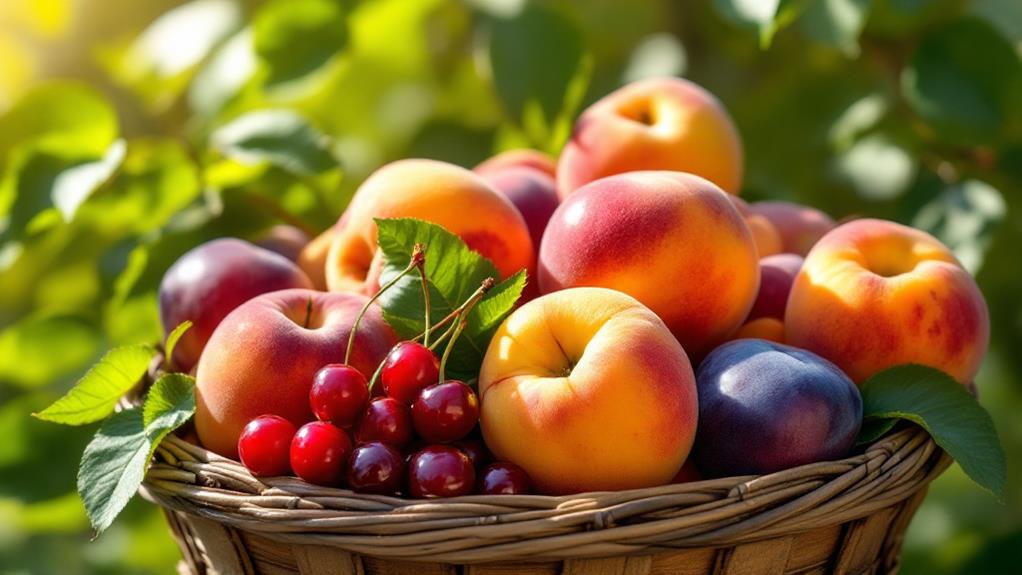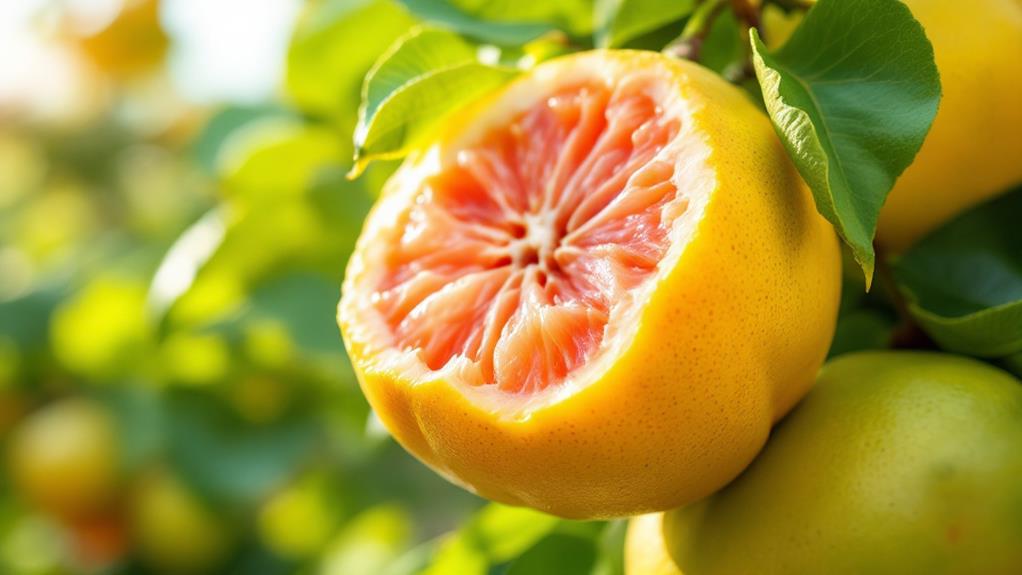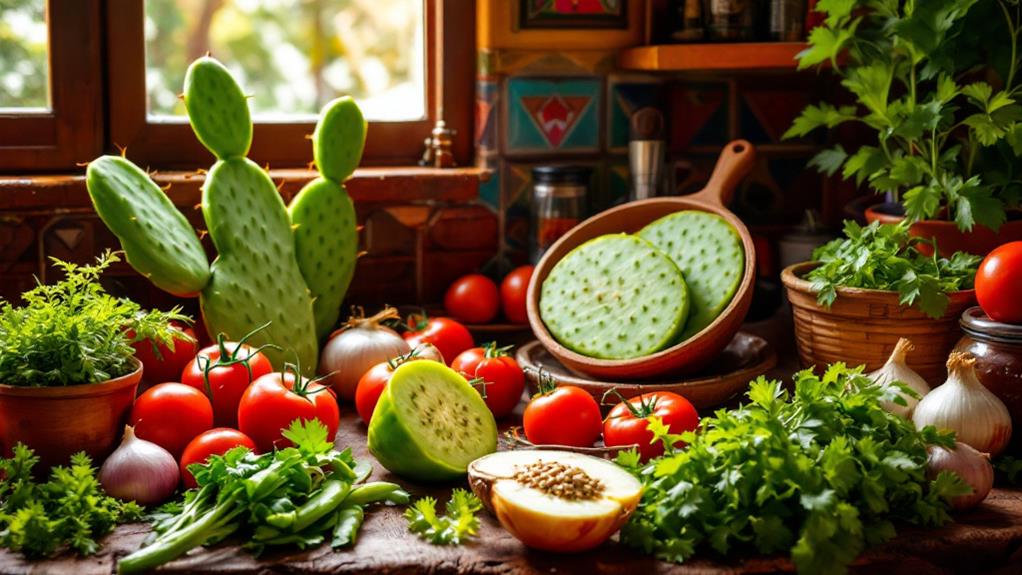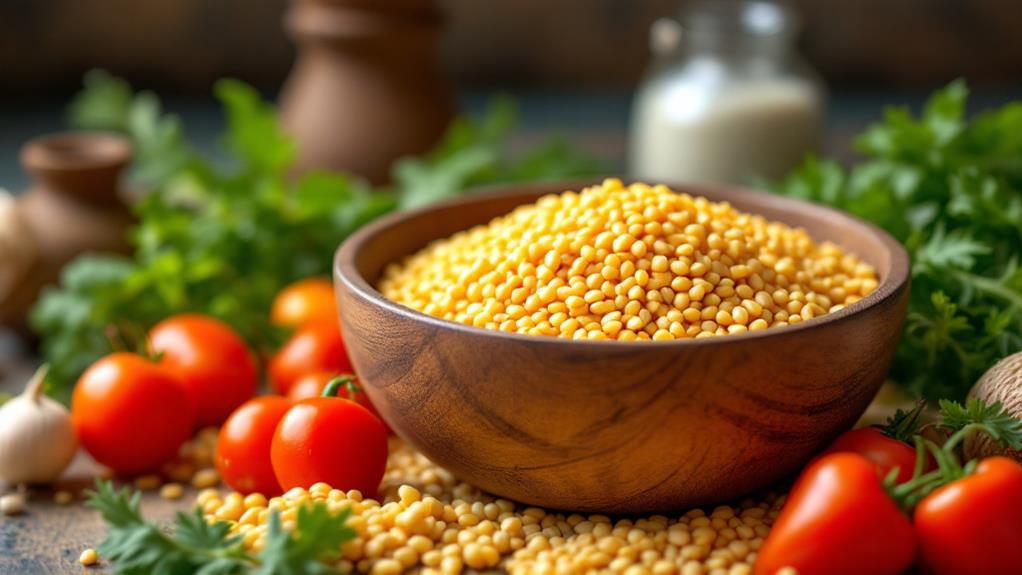Everything You Need to Know About Cassava: Nutrition and Uses
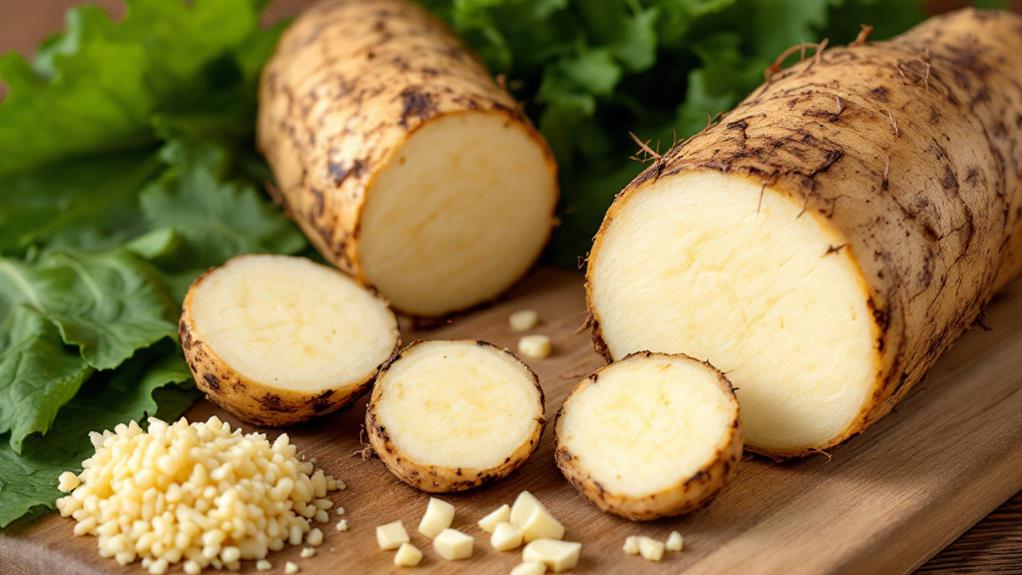
Cassava is a powerhouse staple, rich in carbohydrates and used globally in diverse cuisines. You'll find it's loaded with vitamin C and dietary fiber, bolstering immune function and digestion. Its culinary versatility shines in dishes like fufu, cassava cake, and as gluten-free flour. Don't forget its potential toxicity; proper preparation such as peeling, soaking, and boiling is crucial. This drought-resistant crop thrives in poor soils, contributes to sustainable agriculture, and supports local economies. Whether or not it's in your bubble tea or as a savory side, cassava's culinary and environmental impact is worth knowing about further.
What Is Cassava?
Cassava, often known as yuca or manioc, is frequently an indispensable source of sustenance in tropical regions. This starchy root vegetable originates from South America and has become a major calorie source in places like Nigeria, Thailand, and Indonesia. With its high carbohydrate content—38 grams per 100 grams—it plays a vital role in food security, particularly in areas where other crops struggle. Cassava's ability to thrive in drought and poor soil conditions makes it incredibly versatile and a staple for approximately 800 million people across the globe.
You might be surprised to learn that, despite its benefits, cassava contains cyanogenic glycosides, toxic compounds that necessitate careful preparation. To make it safe, you'll need to follow specific cooking methods such as peeling, soaking, and boiling the root. Properly prepared cassava can then be incorporated into a variety of dishes, providing a reliable energy source without the risk of toxicity. Its uses extend beyond just being a food staple; the root can also be transformed into flour, bread, and even beverages, showcasing its versatility and significance in maintaining food security in many regions.
Nutritional Profile
Beyond its role as a staple food, this root vegetable offers a remarkable nutritional profile that contributes to its widespread consumption. Cassava is a powerhouse of carbohydrates, providing about 40 grams per serving, which accounts for approximately 84% of its total calorie content. This makes it an excellent energy source, especially for those in need of quick fuel. What's more, the root is rich in dietary fiber, with about 2 grams per serving, helping to support your digestive system.
You'll find that cassava is high in vitamin C, offering about 20% of the daily value per serving. This vitamin is essential for maintaining immune function and aiding in collagen production. Furthermore, cassava contains resistant starch, a unique component that acts as a prebiotic. This type of starch is beneficial for gut health, as it feeds your good bacteria, and may also help reduce the risk of metabolic disorders like type 2 diabetes.
Additionally, cassava is a good source of copper, providing around 12% of the daily value. Copper supports energy production and neurotransmitter synthesis, further adding to cassava's impressive nutritional value.
Health Benefits
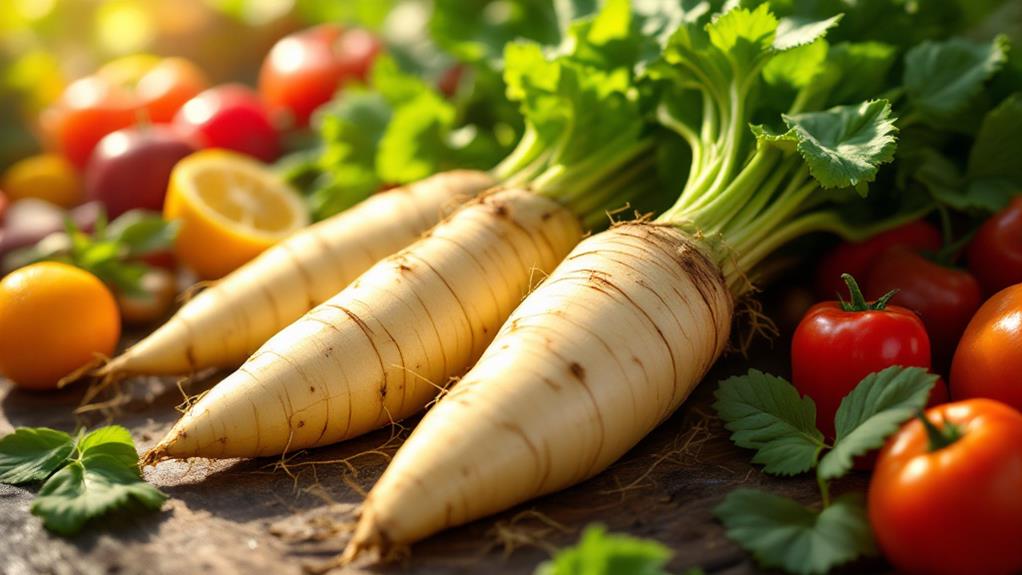
With its impressive nutritional profile, cassava offers numerous health benefits that make it a staple in many diets. When you consume cooked cassava, you're tapping into a rich source of carbohydrates that provides energy, with about 38 grams per 100 grams. This makes it an excellent choice if you're looking to fuel your body efficiently. Beyond just energy, cassava's high content of resistant starch acts as a prebiotic, supporting gut health by nurturing beneficial bacteria. This can contribute to improved metabolic health, potentially reducing risks of disorders like type 2 diabetes.
Cassava is also an excellent source of vitamin C, which plays a significant role in supporting your immune function and collagen production. By providing around 20% of your Daily Value per serving, vitamin C from cassava helps maintain your skin and bones in top condition. The nutritional content doesn't stop there; cassava is packed with important minerals such as copper, potassium, and magnesium. These minerals are crucial for energy production, muscle maintenance, and comprehensive well-being. So, when you incorporate cassava into your meals, you're not only enjoying a versatile food but also reaping its impressive health benefits.
Culinary Applications
Having investigated cassava's health benefits, let's turn our attention to its culinary versatility. Cassava can be prepared in numerous ways, making it a staple in many kitchens. Regardless of you're boiling, baking, frying, or mashing it, cassava offers a wide range of culinary applications. It's processed into cassava flour, which is a popular gluten-free alternative perfect for those avoiding wheat. You can use it in pancakes, bread, and other baked goods, providing a texture similar to sweet potatoes with added nutritional benefits.
Traditional dishes like cassava cake, fufu, and farofa highlight its significance in tropical cuisines. These dishes showcase cassava's ability to adapt to different flavors and preparations. If you're into snacks, try making fried cassava chips — they're a crunchy delight and a fantastic alternative to potato chips.
For dessert enthusiasts, tapioca pearls, derived from cassava, are crucial. Use them in puddings or bubble tea to add a chewy texture and a touch of exotic flair. Cassava's versatile preparations allow you to investigate its potential in countless dishes, making it a valuable enhancement to your culinary repertoire. With cassava, the possibilities are endless!
Safe Preparation Methods
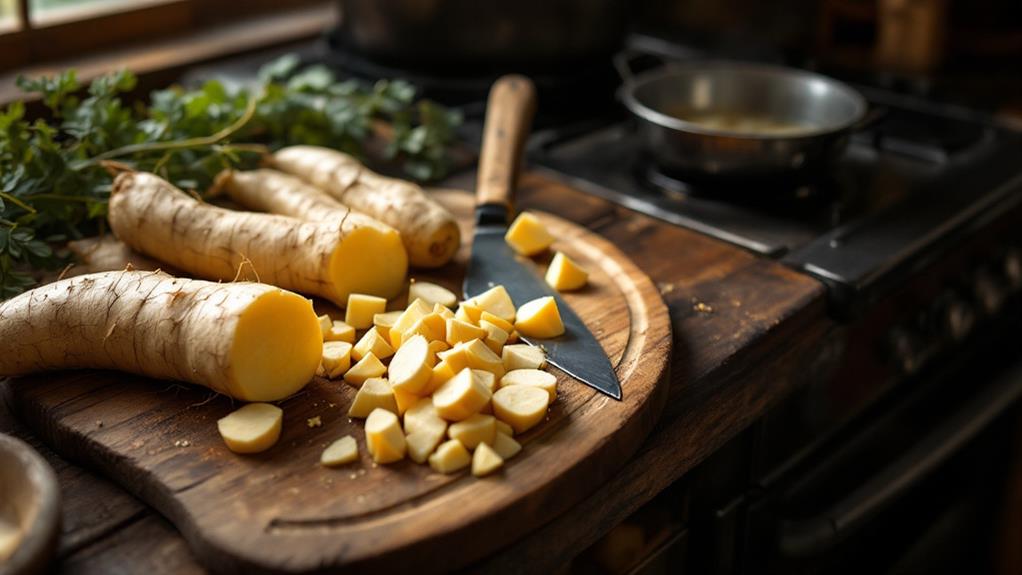
When preparing cassava, it is essential to prioritize safety due to its natural cyanogenic glycosides, which can release cyanide if not handled correctly. To guarantee safe preparation methods, start by peeling and slicing the raw cassava. Soak the pieces in water for 48-60 hours to greatly reduce harmful compounds. This soaking process is important, as it helps break down the cyanogenic glycosides, making the cassava safer to consume and preserving its nutritional value.
Once soaked, proceed to cook the cassava. Boiling is one of the most effective methods, as it not only retains the nutrition of the cassava but also further reduces any remaining toxicity. Alternatively, you can bake or fry the cassava, though boiling is generally preferred for safety. If you're dealing with bitter varieties, extra processing steps such as grating or pounding are necessary before soaking and boiling to guarantee all harmful elements are adequately removed.
For processed products like tapioca, there's no need for extra cooking, as they have already undergone processing steps that eliminate any harmful substances. Following these measures guarantees that cooked cassava is both safe to eat and nutritious.
Toxicity Concerns
Cassava's potential toxicity is a major concern due to its cyanogenic glycosides, which can release cyanide if not properly prepared. Eating raw cassava can lead to cyanide poisoning, a serious health risk. Bitter varieties of cassava contain higher levels of these glycosides compared to sweet varieties, making them especially dangerous if consumed without adequate processing. Symptoms of cyanide poisoning include headache, nausea, dizziness, and in extreme cases, can cause paralysis, neurological disorders, or even death.
To avoid these severe health consequences, it's essential to follow proper preparation methods. Start by peeling the cassava, which removes some of the toxic compounds. Soaking is another effective method; you should soak sweet cassava for 4-6 days. Bitter varieties require more intensive processing, such as grating or pounding before boiling, to greatly reduce cyanide levels. Boiling the cassava is an extra step that helps eliminate any remaining toxins.
Processed products like tapioca, derived from cassava, are generally considered safe. These products undergo rigorous methods to remove harmful compounds, ensuring they don't pose toxicity concerns. Always prioritize proper preparation to safely enjoy cassava's nutritional benefits.
Environmental Impact
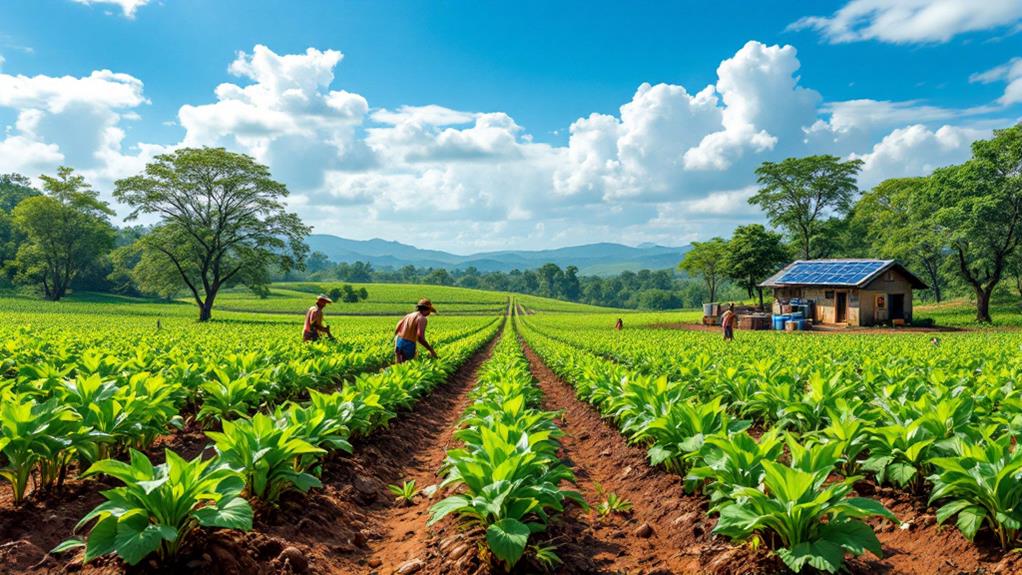
Cassava stands out as an environmentally resilient crop that thrives where many others struggle. This drought-resistant plant grows in poor soils, making it invaluable for food security in developing countries. You'll find it requires markedly less water than other staple crops, which makes it a champion for water conservation, especially in regions experiencing water scarcity.
By intercropping cassava with other plants, you improve biodiversity and optimize land usage, leading to better agricultural yields. This practice not only supports diverse ecosystems but also promotes a sustainable approach to food production. It's a smart strategy, particularly in areas prone to climate change impacts where sustainable farming is essential.
Cultivating cassava helps mitigate the effects of climate change by providing a stable food supply and supporting rural livelihoods during extreme weather conditions. As a resilient crop, it stands firm against environmental challenges, reducing the negative environmental impact of agriculture. You can see how cassava's role in promoting biodiversity and sustaining ecosystems makes it an excellent choice for a future-focused agricultural approach. Embracing cassava cultivation could be a key step in creating a more sustainable and food-secure world.
Cassava in Global Cuisines
A multitude of global cuisines have adopted cassava, transforming this adaptable root into a staple ingredient. In Africa, cassava plays a central role, particularly in the form of fufu. This dough-like food is a must-try when paired with rich soups and stews, offering a taste of the region's culinary traditions. Moving to Brazil, you'll find cassava turned into farofa, a delicious toasted flour dish. Served alongside meats and fish, farofa adds a crunchy texture and a burst of flavor to the Brazilian dining experience.
In Southeast Asia, cassava's versatility shines through in snacks like cassava chips. Perfect for munching, these chips provide a crispy alternative to potato options. Moreover, in the Philippines, cassava cake stands out as a beloved dessert, showcasing the root's sweet side. Cassava isn't just limited to these dishes; its transformation into tapioca pearls has made it a global sensation, especially in bubble tea.
In West Africa, the significance of cassava extends beyond the root. Cassava leaves are cooked as a nutritious vegetable, enriching local diets. Each region's unique approach highlights cassava's adaptability, making it a crucial part of tropical cuisines worldwide.
Future of Cassava

The future of cassava looks bright, especially as it's recognized for its resilience to climate change. Cassava cultivation thrives with less water and fertilizer, making it a robust option for drought-prone areas. This high resilience guarantees that cassava can bolster food security in regions facing climate challenges. Researchers are also developing low-cyanide varieties through genetic modification, guaranteeing safer and more nutritious consumption for everyone.
With the rising demand for gluten-free products, cassava flour is gaining popularity. As more people adopt gluten-free diets, the market for cassava flour is set to grow considerably. It's a versatile ingredient that seamlessly fits into a variety of recipes, making it a favorite among health-conscious consumers.
Cassava isn't just about food, though. Its potential in bioethanol production shines as an alternative energy source. By contributing to sustainable energy solutions, cassava helps reduce reliance on fossil fuels. Furthermore, improving processing techniques, including traditional fermentation, enhances its health benefits while minimizing toxicity risks. With these advancements, cassava stands to play a crucial role in a sustainable and healthy future, adapting to our changing world and dietary needs.

